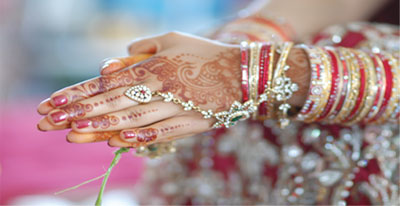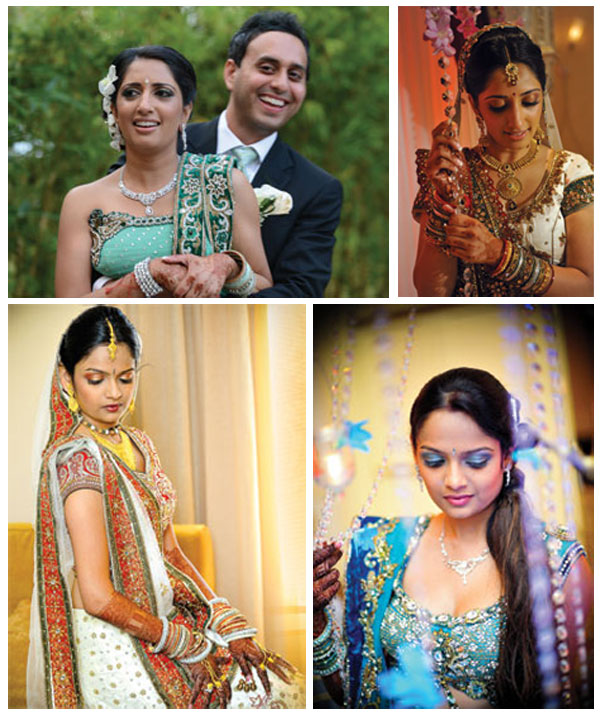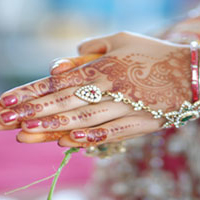Solah Shrinagar: How to Be an Elegant Bride

Take a look at any Indian bride and you can almost see a halo around her. She radiates happiness and anticipation, and always ends up being the cynosure of all eyes. While the natural blush and glow comes from the energy and positivity within, what contributes significantly to her beauty on the day are elements that are traditional to every Indian wedding. Decorative adornments that an Indian bride uses are what make the Indian bride truly stand out.
There are in all sixteen elements that constitute the Indian bride.
These are collectively called solahshringar – the word solah meaning sixteen in Hindi, and shringar meaning decorations. Here are some details on what each of them is, and how they can be best put to use.
The first, and most important is the wedding attire. While all Indian brides stick to traditional Indian attire on this day, they make use of the liberty allowed within this range. Saris and lehngas are the most commonly worn bridal outfits. The traditional Indian bridal dress is usually in shades of red or maroon, which are considered auspicious, with golden work woven in to accentuate beauty and add a touch of glamour. Today, many brides look for other colors that better suit them or are the latest fashion.
Most brides use flowers in their hair, which makes up the next component of the solah shringar, and rightly so, since they add a shade of color, fragrance and an angelic quality. Flowers can be chosen to match the outfit the bride wears, or even in traditional forms like roses or jasmine. Brides also sometimes like to choose artificial flowers that can be combined with embellishments like diamonds to fashion into their hair pins and clips. Flowers can be worn with braids that are left loose, or even in knots and buns that are tied up.
The eyes are a very prominent feature of the bride. They stand out, and also convey the happiness and bashfulness of the bride. The eyes are made to stand out with the use of kohl –a thick black coat that is applied to the eyes to help them look bigger and brighter. Today, of course, other forms of eye make-up like liner, mascara and color are also used.
The bindi or the vermillion dot is very important. It is a prominent Hindu symbol of all married women and brides. The conventional color of the bindi is red, with smaller white dots that are lined along the top of the eyebrows. The bindi is used to denote auspiciousness and longevity of the husband, and also to ward away the evil eye. While the practice of wearing the white dots is not as common anymore, the red dot in the centre has also been substituted by other colors that better complement the outfit, and in designs that are more attractive.
A maangtikka is an accessory that is worn in the center along the part of the hair. It is made with the use of pearls, semi precious stones and is set in gold. A pendant like decoration hangs at the end of the parting on the forehead and stands out, adding a touch of beauty.
While all brides do not have their noses pierced, the nose ring is another important element. While some brides prefer a small ring or stone, others like to go with the tradition of wearing a large gold ring with a gold chain that extends to the back of the ear. Brides who do not have their noses pierced sometimes avoid this element,
or simply use a clip-on nose ring.
All brides wear earrings. On this day, they are especially elaborate, and most often long. They usually match the outfit that is worn, and can be made with the use of only gold, colored stones or even diamonds.
Chains and necklaces are another integral part of the solah shringar. Most brides wear more than one chain, starting with a high choker or chain, and graduating to longer necklaces that offer a layered effect. The most important, the mangal sutra is tied by the groom during the ceremony.
The bride usually wears a baajuband, which is an amulet work over the blouse around the arm. Made conventionally in gold, colors and stones are also used when designing and making these today.
Mehndi is very important for every bride. Intricate, elaborate designs on the hands and legs of the bride are made with henna, including depictions of brides and grooms, elephants and peacocks, the wedding procession or baraat, and the religious pot or kalash. A special ceremony known as the mehndi ceremony is arranged so that the bride and close relatives and friends can celebrate and have the henna applied.
Every bride wears bangles and bracelets on their arms. While there is nothing to dictate jus t how many and what kind must be worn, brides usually wear plenty of bangles in various colors and patterns. Using a mix of gold and stones, glass and designer bangles, brides try and complement the look of their wedding ensemble.
All brides wear rings on their fingers. While some may only wear the diamond engagement ring, others often opt for the traditional eight rings that are worn on all fingers, and attached to one another with gold chains and a central pendant thatis at the back of the hand.
A delicate belt is worn by the bride and is called a kamarband. This may be made from either gold or silver, and can be made in various thicknesses with the use of intricate designs and stones. The purpose of the kamarband is to help keep the outfit draped perfectly, and also to help highlight the area around the waist.
Anklets are a must for every bride. While some brides prefer delicate silver strings around their ankles, others look for heavy pairs that have several layers and bells.
A fragrance or perfume helps make the bride smell inviting, and keeps her feeling fresh through the day.
The final shringar is the sindoor, or mark of vermillion thatthe groom places along the part of the bride’s hair as a mark of marriage. This is worn below the maangtikka, and the bride usually wears it everyday thereafter.
When you plan your wedding, ensure you have thought of each of these elements. You will no doubt be sure to look not just traditional, but also elegant and stunning. Each will complement you perfectly, and transform you in ways you never thought possible.



















Leave a Reply
You must be logged in to post a comment.